Blair Castle: The Seat of the Dukes of Atholl, part 1 by Arthur Oswald
From the Country Life Archive: Arthur Oswald reports on the historic fortress of Atholl lies in Strath Garry, three miles above the Pass of Killiecrankie. After being turned into a Georgian mansion in 1747-49, it regained its castellated appearance in 1869, when the exterior was remodelled by Bryce. Originally published in Country Life, November 4, 1949.


RETURN TO THE SCOTTISH CASTLES HOMEPAGE
The great tract of moor and mountain embraced by Atholl comprises the greater part of northern Perthshire and represents with Gowry to the east one of the seven original carldoms of Scotland corresponding to the seven twofold provinces of the Pictish kingdom. Whoever held this region held the key to the main route from Perth to Inverness, piercing the Central Highlands by the valleys of the Tay, Tummel and Gany. The Tay is joined by its tributary, the Tummel, at Ballinluig, and about seven miles farther on, above Pitlochry, the Tummel receives the Garry, just as it has emerged from the Pass of Killiecrankie. To force that formidable and romantic defile the railway resorts to the aid of a tunnel, while the road climbs above it, before entering Strath Garry, in which Blair Atholl lies some three miles farther on, where Glen Tilt comes in from the north. Two centuries of planting have done much to tame the original wildness of the scene, and Blair Castle stands in a park that spreads across the valley, here quite wide between the two streams, and extends up the lower slopes on the north side. It is approached from the south by a long straight avenue of limes.
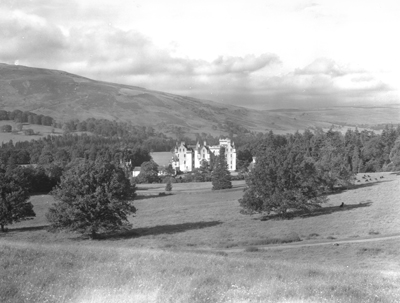
Fig 1. The castle from the eastern slopes of the park.
From a first glance at the battlements, stepped gables and bartizans rising above the white, harled walls the visitor may be in some doubt whether he is looking at an authentic Scottish castle or a Scottish Baronial pile. In fact, it is both. But on either assumption he is left totally unprepared for the magnificent series of mid-Georgian rooms which comprise the greater part of the interior and of which the only, external hint is to be found in the sashed windows pierced in the thick walls. The castle has undergone two reconstructions, once in the 1740s and a second time between 1869 and 1872, when the baronial features were applied by Bryce, with considerable discretion to what had become to all appearances a Georgian house. These processes will be described in greater detail later on. The main front of the castle (Fig 3) faces north-east, but for convenience it will be assumed that it is east and that the remaining sides look to the other three points of the compass. At the north end (right of Fig 3) there is a battlemented tower, the lower part of which is the oldest portion of the building. The harled surface of the walls and the two reconstructions make it impossible to date it accurately, but its traditional name, Cumming's Tower, links it with the earliest record of the castle that has survived.
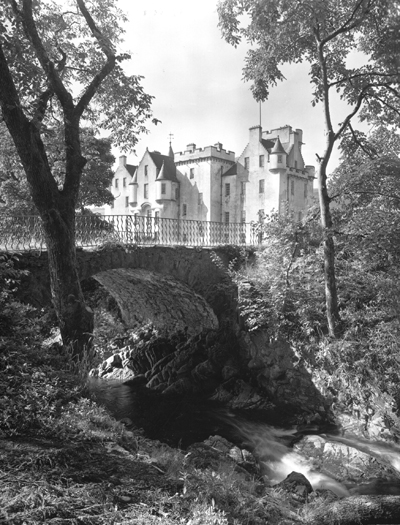
Fig 2. From the banks of the burn.
Madach, brother of Malcolm III, is the first Earl of Atholl known to the editors of The Complete Peerage. As Madach comes he was one of the signatories to the charter of Scone of 1115. About 1250 the earldom came by marriage into the Strathbogie family, and in 1269 David Strathbogie, Earl of Atholl, is found complaining that during his absence John Comyn, or Cumming, of Badenoch had made an incursion into Atholl and had begun building a castle at Blair. The intruder was the father of Robert Bruce's victim. Whether the tower which Cumming attempted to build was the first building to occupy the site there is no means of deciding, but Blair was the chief seat of the earldom from early times. The next reference to the castle is in 1336, when Edward III lodged in it on his way north to raid the Highlands. By that time the Strathbogie family had forfeited the earldom, although they continued to be recognised by the English King. In 1342 it was bestowed on Robert Stewart, but became merged in the Crown when he succeeded to the throne as Robert II.

Fig 3. The entrance front from the north. Cumming's Tower, the oldest part of the castle, is on the right.
Sign up for the Country Life Newsletter
Exquisite houses, the beauty of Nature, and how to get the most from your life, straight to your inbox.
Other members of the Royal house held the earldom for short periods, but in 1457 it was conferred on Sir James Stewart of Balvenie, James II's half-brother, and ancestor of the present Atholl family. In 1475 the new Earl quelled the insurrection of John Macdonald, Lord of the Isles. "Furth fortune and fill the fetters" were the words with which James III is said to have sped him on his way, and they have remained the Atholl motto ever since. The second Earl fought at Flodden, where it is sometimes said that he was slain, but he survived until 1521, and in the following year sasine in the lands of the earldom was taken at the castle of Blair in favour of his son. The third Earl in 1529 provided a princely entertainment in honour of James V and the French ambassador at a great hunting match in the Forest of Atholl, having erected a curious palace of wood in a green meadow for the banquet. To him is usually attributed the building of the hall range extending southward from Cumming's Tower. It now contains the dining-room at first-floor level and above it the great drawing-room, both of which will be illustrated in the second article. The two rows of four windows seen to the right of Cumming's Tower in Fig 4 show the extent of this 16th-century range.

Fig 4. The west front from the south.
In the vaulted basement of this part of the building there is now a Stewart room in which are gathered together some of the earlier pictures, furniture and relics of the period. Here are two early portraits in pairs of James V and his queen, Mary of Guise, and of Mary Queen of Scots and her son, James VI - the latter a reminder that the fourth Earl was one of her most loyal supporters. In 1578 he ousted Morton from the Regency with the aid of Argyll and became Chancellor, but in the following year died suddenly in circumstances which suggested that he had been poisoned. A few days before his death he had been feasted by Morton at Stirling in token of their reconciliation, and the obvious conclusions were drawn, though not proved. A letter of condolence from Mary Queen of Scots was received by his widowed Countess, who was a sister of Mary Fleming, one of the Marys who were the queen's maids of honour. A copy of this is displayed in the Stewart room, where there also hangs a formidable object - the two-handed executioner's sword used under hereditable powers of jurisdiction belonging to the earls.
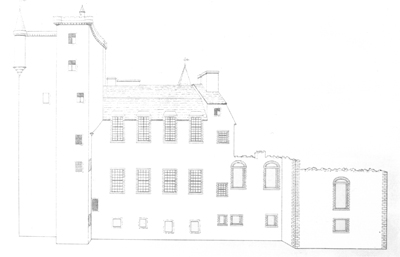

Figs 5 and 6. The castle in 1736 from drawings made by C. Frederick, showing the unfinished south end.
On the death of the fifth Earl in 1595 without male heirs the earldom reverted to the Crown and was conferred on the dowager countess's second husband, Lord Innermeath, also a Stewart; but this creation ended with the death of his son in 1625. Four years later the earldom was revived in favour of John Murray, son of William, Earl of Tullibardine. His mother was Lady Dorothea Stewart, daughter and co-heiress of the fifth Earl, and so the new line was lineally descended from the Stewart Earls of Atholl.
In the Civil Wars, as again in 1689, 1715 and 1745, Blair by virtue of its strategic position on the Highland route played a conspicuous part. The first Murray Earl was a Royalist but died in 1642, leaving a boy of eleven to succeed him. Like Montrose, he had signed the National Covenant of 1638, one of the four original copies of which is preserved at Blair. (Another, recently brought back from Australia, is now at Dunblane Cathedral.) It was at Blair that Montrose raised the King's standard in 1614 and the Athollmen were prominent in the brilliant campaign which he fought. From 1652 until the Restoration a Cromwellian garrison was installed in the castle. The young Earl joined the Highland rising of 1653 and made an unsuccessful attempt to recapture the castle. Three skeletons found buried under the floor of one of the vaulted rooms below the dining-room are believed to have been those of defending soldiers killed by the assailants.

Fig 7. The entrance front after the alterations of 1747-49.

Fig 8. The same front today as remodelled by Bryce.
After the Restoration numerous offices were conferred on the second Earl; he became Justice-General of Scotland and in 1672 Keeper of the Privy Seal; four years later, he was created Marquess of Atholl. He was at the Battle of Bothwell Brig (1679), but the excesses then perpetrated on the luckless Covenanters caused him to withdraw his support of the Duke of Lauderdale and afterwards he was able to secure some mitigation of the severeties meted out to them. At the Revolution, partly influenced by his son, Lord Murray, who had become a Whig, he gave his allegiance to King William, and when the Battle of Killiecrankie took place a few miles down the valley from Blair, he was remote from the scene, having retired to Bath for his health. The influence of the Marquess and his son was sufficient to prevent the Athollmen from joining Dundee, and none were with him when he overwhelmed Mackay's force in the pass but himself fell mortally wounded. At Dundee's orders, however, the Marquess's bailie, Stewart of Ballechin, had seized the castle in the absence of Lord Murray, and when Murray arrived on the scene to recapture it, he was deserted by most of his men and had to abandon the attempt. After the battle Dundee's body was buried in the old parish church at Blair in the Atholl vault. Macaulay, piling on the superlatives, has branded the Marquess as "the falsest, the most fickle, the most pusillanimous of mankind," but his account of the Marquess's behaviour is a travesty of the facts. Old and ailing, and anxious to be "as much as possible out of the world," the Marquess left the conduct of affairs in Scotland to his son, who did his best in the circumstances. Correspondence published since Macaulay wrote proves the imputation of treachery to be unfounded.
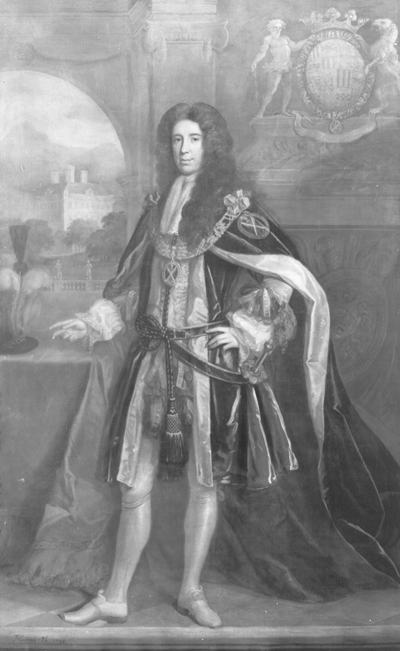
Fig 9. John, 1st Duke of Atholl, by Thomas Murray. Signed and dated 1705.
On one of the walls of the Picture Staircase at Blair there is a full-length portrait of the Marquess by Jakob de Witt, the artist who was commissioned to paint the series of portraits of the Scottish kings at Holyroodhouse. He appears in the guise Julius Cesar, wearing somewhat scanty Roman attire and a wig, and the Battle of Bothwell Brig is indicated in the background (Fig 10). The Marquess's attitude in acknowledging William of Orange is sometimes attributed to the influence of his wife. She was Lady Amelia Stanley, a daughter of the seventh Earl of Derby, and by her mother, Charlotte de la Tremouille (the lady celebrated by Sir Walter Scott in Peveril of the Peak for her heroic defence of Latham Castle), was nearly dated to the house of Orange. Portraits of the Countess and some of her ancestors hang on the Picture Staircase at Blair, as does that of Lady Amelia seen over the door in Fig 11.
At the time of the '15 the Atholl family were divided in their allegiances as they had been at the Revolution, but this part of the story must be left until next week. The second Marquess, who shortly after his father's death in 1703 was created Duke of Atholl, figures in a full-length portrait by the Scottish artist, Thomas Murray, a pupil of Riley (Fig 9). It is signed and dated 1705. The duke, magnificent in his robes, is painted against an architectural setting with a view of old Dunkeld House seen through an arch in the background. Another full-length, hanging at the head of the Picture Staircase (Fig 11), is Davison's portrait of the second Duke (1690-1764), to whom the first reconstruction of the castle and the staircase itself are due.
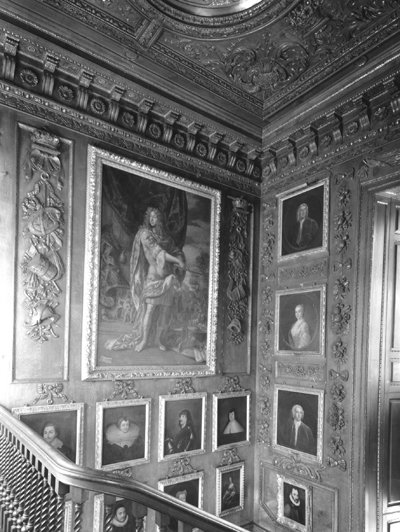
Fig 10. Portraits on the walls of the Picture Staircase. The full-length figure in Roman dress is John, Marquess of Atholl (1631-1703).
Two rather crude drawings made in 1736 and signed "C. Frederick" show the castle at that date. Figs 5 and 6 are copies of them. Cummings Tower with the turret projecting from its west face is seen on the left of Fig 5; extending southward from it is the 16th-century hall range, and beyond it appears a ruined or unfinished building, to which there is a reference in a letter written in April 1710. The Earl of Orkney is writing to the first Duke:
"I am glad yr Gr. tacks such delight in Blaire; indeed of all the Houses I ever saw of yr Grace's I lyke it the best; if you maike up that end that was ruinous you will certainly have a very noble House."
The ruinous end, however, remained unfinished until after the '45. The view of the entrance front (Fig 6, which should be compared with Fig 8) shows the east face of Cumming's Tower on the right; it had, as it now has again, a stepped gable and a bartizan at the angle, but these were probably 16th-century additions to the medieaval tower. To the left of it and coming forward a few feet is a staircase block (now battlemented) which was inserted in the angle between Cumming's Tower and the hall range, probably in the first half of the 17th century, to provide a broader ascent than the spiral stairs. One of these spiral stairs is seen in the round tower at the south-east angle of the hall range; it had been heightened to provide two little rooms one above the other, corbelled out above the tower and crowned with a gable. These eyries were removed in 1747, and in 1872, when the new entrance hall was built partly obscuring the stair turret, a conical roof was substituted.
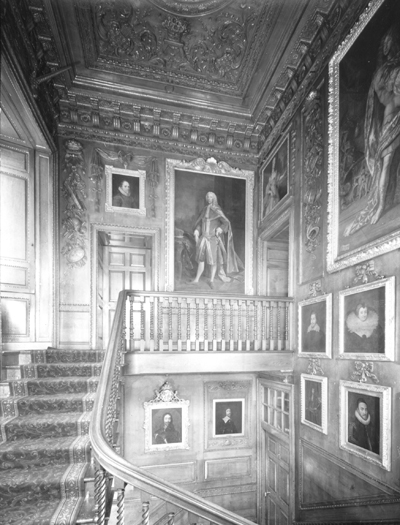
Fig 11. The head of the Picture Staircase.
The second Duke, James, who succeeded in 1724, since his Jacobite elder brother, William, had been attainted after the '15, turned his attention first to the gardens and grounds, enclosing the land round the castle, laying out walks and planting. These works, begun in 1732, occupied him for some years, but in 1736 he obtained plans from an architect named Douglas for raising the unfinished south end to the height of the main building. Nothing seems to have been done then, however, for in March, 1746, when the castle was besieged by Lord George Murray and his Highlanders, this end of the building is expressly mentioned as being "only carried up to a few feet above some beams or joists fixed for the first floor." The words are those of General Robert Melville, who as an ensign was one of the garrison at the time of the siege, of which he left a detailed account. Considerable damage was done to the roof of the house by Lord George's cannon and all the windows were broken. When the Duke regained possession of the castle, he decided not merely to repair the damage but to modernise the whole fabric. In 1743-44 he had already built new stables and a long detached wing of offices to the south-east of the castle (left of Fig 3). His architect for these additions was James Winter, who was now required to prepare plans for a drastic remodelling of the main building and the replanning and decoration of its rooms.
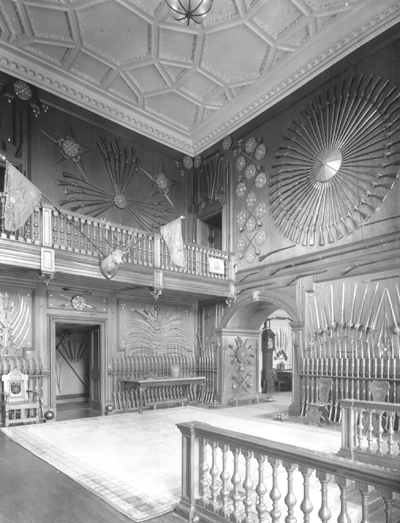
Fig 12. Arms and colours in the entrance hall.
Letters written to the Duke by his secretary, Humphry Harrison, kept him posted with the progress of the work. It began in 1747. The structural alterations took rather over two years, but the work of fitting up and furnishing the interior was not completed until 1758. The unfinished south end was built up to the height of the hall range; the high gables and roof were taken down and replaced by hipped roofs of low pitch; and the two top storeys were removed from Cumming's Tower to reduce it to the height of the rest of the building, a process described in the letters as the "clipping of the castle." By the time that these drastic alterations had been finished, sashed windows introduced and an entrance hall added to the east front, the building had acquired the semblance of a Georgian mansion - a rather unsymmetrical one, however (Fig 7); and to signify the change of character which it had undergone the Duke renamed it Atholl House.
Thus shorn and trimmed the erstwhile castle remained until 1869. The seventh Duke then decided to re-castellate the building, employing David Bryce as his architect. If not the inventor of Scottish Baronial, Bryce was the principal exponent of the style. Though he also produced Italian designs, his extensive practice was largely concerned with the building of new "baronial" mansions and the alteration and restoration of old ones. He had a good eye for effective grouping and striking silhouette, qualities that are apparent in his work at Blair, where he showed more reticence than in some of his buildings. The photographs show the result of his alterations, which must have been based to some extent on the Frederick drawings. Cumming's Tower regained its old altitude and the projecting turret on the west face was finished off with castellations. Stepped gables and bartizans reappeared but in greater profusion. The Georgian entrance hall was replaced by a much larger and more commanding feature, with twin bastions flanking the doorway and breaking out above into bartizans with conical roofs, the whole rising to a stepped gable. Internally the entrance hall is two storeys in height, and its walls are decorated with weapons and firearms skilfully arranged in patterns (Fig 12). They include old Highland broadswords and dirks, the targes and swords carried by the Atholl Highlanders up to 1845, and flintlock muskets used by the Volunteers during the Napoleonic wars. The two five-pointed stars on the wall above the gallery are made up of groups of bayonets each centring in a brass-mounted Highland targe. The colours are those of the Atholl Highlanders. They were presented by Queen Victoria after her visit to Blair Castle in 1844, since which time this family bodyguard has been allowed to carry arms.
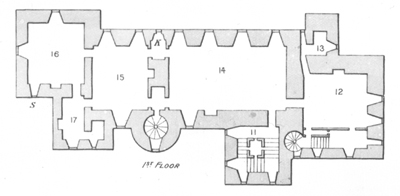
Fig 13. First-floor plan of the castle in 1736.
In 1876 a ballroom was built at the north-west corner of the castle. Bryce again made the designs but died just as the work began. The range running at right angles to the south wing and linking it to the south end of the castle (Fig 3) had been built about 1748. The clock-tower, however, was added in 1814, after a fire had gutted this part of the building, but it did not acquire its pyramidal roof until 1886.
The interior will be described next week, and we need here call attention only to the fine plasterwork decorating the Picture Staircase (Figs 10 and 11), or the Stucco Stair, as it was originally called. The graining of the woodwork, walls and ceiling was done in 1845 and imparts a warm, mellow effect, though perhaps not what was originally intended.
If you are interested in additional photographs of this property, please contact the Country Life Picture Library.
RETURN TO THE SCOTTISH CASTLES HOMEPAGE
BALMORAL CASTLE: A HIGHLAND PARADISE BY MARY MIERS (FREE PDF DOWNLOAD)
CRAIGIEVAR CASTLE: THE SEAT OF SIR JOHN FORBES, BART., NOW LORD SEMPILL BY PETER GRAHAM
CULZEAN CASTLE: THE SEAT OF THE MARQUESS OF AILSA, PART 1 BY ARTHUR T. BOLTON
EILEAN DONAN CASTLE: THE PROPERTY OF THE CONCHRA CHARITABLE TRUST BY ANTONY WOODWARD
GLAMIS CASTLE: THE SEAT OF THE EARL OF STRATHMORE, PART 1 BY OLIVER HILL
HOLYROODHOUSE: SCOTLAND'S ROYAL PALACE BY SIMON THURLEY (FREE PDF DOWNLOAD)
SCONE PALACE: THE SEAT OF THE EARL OF MANSFIELD AND MANSFIELD, PART 1 BY JOHN CORNFORTH
STIRLING CASTLE: RENAISSANCE OF A ROYAL PALACE BY JOHN GOODALL
Agnes has worked for Country Life in various guises — across print, digital and specialist editorial projects — before finally finding her spiritual home on the Features Desk. A graduate of Central St. Martins College of Art & Design she has worked on luxury titles including GQ and Wallpaper* and has written for Condé Nast Contract Publishing, Horse & Hound, Esquire and The Independent on Sunday. She is currently writing a book about dogs, due to be published by Rizzoli New York in September 2025.
-
 How many bees, Channel 4 and a Catch 22: Country Life Quiz of the Day, May 6, 2025
How many bees, Channel 4 and a Catch 22: Country Life Quiz of the Day, May 6, 2025Tuesday's Quiz of the Day features a famous road, nature and science.
-
 Tasburgh Hall: From a Buddhist centre to a seven-bedroom family home in 23 acres
Tasburgh Hall: From a Buddhist centre to a seven-bedroom family home in 23 acresThe property, in Norfolk, was once four separate apartments, but has been lovingly re-stitched back together.